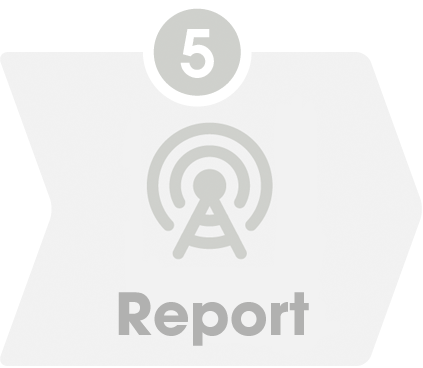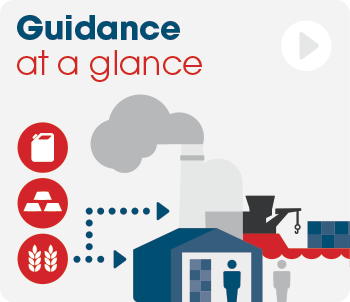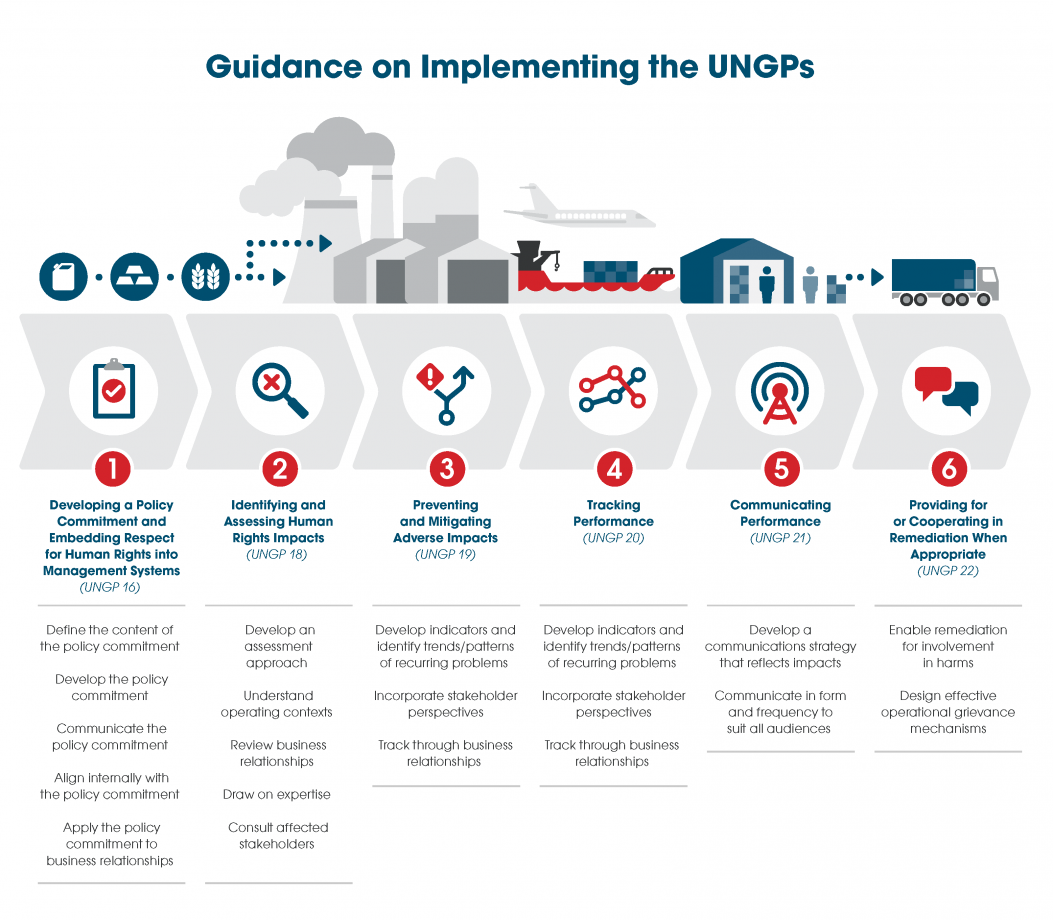Key Actions
v. Consult affected stakeholders
As part of efforts to identify and assess actual or potential adverse human rights impacts, the UNGPs state that companies should undertake “meaningful consultation with potentially affected groups and other relevant stakeholders, as appropriate to the size of the business enterprise and the nature and context of the operation” (UNGP 18b).
Affected stakeholders are individuals whose human rights may be impacted by a company’s operations, products or services (see Stage 4, ii. Incorporate stakeholder perspectives). Engaging with these individuals helps companies build mutual understanding of the human rights risks at stake and find effective ways to address them.
Commodity Trading and Affected Groups
Commodity trading may include potential adverse impacts on a range of affected groups including:
- Employees/contractors/workers (including migrant workers)
- Local producers and their workers
- Local communities
- Indigenous people
- Vulnerable and marginalised groups
- Supply chain/contractor workers
- Human rights defenders*
The UNGPs Interpretive Guide states that stakeholder engagement/consultation is an “ongoing process of interaction and dialogue between an enterprise and its potentially affected stakeholders that enables the enterprise to hear, understand and respond to their interests and concerns, including through collaborative approaches.” (See UNGPs Interpretive Guide, p8). Such engagement helps build constructive relationships based on good faith with employees, local communities, civil society actors and others and should be part of a company’s efforts to “assess its impact and to gain feedback on how effectively it has responded to impact.” (See UNGPs Interpretive Guide, p62).
The box below provides an example of how a commodity trading company could integrate stakeholder engagement into its corporate responsibility strategy.
Example A Five Step Approach to Stakeholder Engagement
The following five step approach provides an example of stakeholder engagement that a commodity trading company may apply to its operations:
-
The company’s top managers set an initial overall vision of reaching out broadly to all external stakeholders about its new corporate code of conduct and related issues, including the challenging task of engaging local stakeholders in countries where commodities the company trades are produced. The top managers also called for a review of the company’s past stakeholder engagement policies and actions. This review asked questions such as:
- What lessons did we learn from any previous attempts to engage stakeholders?
- Did these efforts provide helpful information or fulfill other company objectives?
- Were the formats for our past engagement appropriate for those involved?
- Did we seek feedback to determine if we addressed stakeholders’ concerns/expectations?
- Which internal stakeholders need to be involved? How?
-
The company’s top managers appointed an in-house cross functional team to undertake an initial stakeholder mapping process designed to identify and prioritise the company’s external stakeholders followed by proposals for appropriate engagement mechanisms. This process involved:
- Brainstorming a list of stakeholders, including everyone who had an interest in the company’s activities today and who may have one in the future. Where possible, the process involved identifying individuals and organisations by name in the country where the company is based as well as in countries where a significant portion of commodities traded are produced.
- Analysing whether those stakeholders identified had information, expertise and broad legitimacy and the extent to which they were willing to participate in engagement activities.
- Prioritising those individuals/organizations where company engagement objectives could be best achieved and where issues of relevance and concern seem most aligned with stakeholder issues and priorities.
-
After completing the mapping, the in-house team proposed a number of initial activities to test stakeholder engagement, which involved:
- organising face-to-face meetings with interested external stakeholders at the company’s headquarters to discuss social and environmental performance and;
- preparing online outreach initiatives involving webinars for interested external stakeholders on specific topics.
-
Top managers approved the plan and agreed to participate in the face-to-face meetings. These invitation-only events were held at a local conference centre and the initial participant limit was set at 30. The online webinars were organised with assistance from an external facilitator and each focused on supply chain issues in the four main commodities traded by the company. Producers of commodities identified with support from an external facilitator took part in 2 of the webinars.
-
At the end of the initial engagement events, the in-house team prepared a report for top managers outlining main concerns raised by participants as well as proposed plans for follow-up actions. Top managers agreed to the proposed next steps including semi-annual stakeholder engagement events organised
by the in-house team. In an effort to align with good practice, the in-house team agreed to review their past efforts and plan future engagement in the context of the UNGPs and relevant resources including the OECD Due Diligence Guidance for Meaningful Stakeholder Engagement in the Extractive Sector.
Adapted from BSR’s Back to Basics: How to Make Stakeholder Engagement Meaningful for Your Company, 2012
A number of industry focused and market specific tools have been developed to assist companies in carrying out effective consultations with stakeholder groups. For example, in 2017 the OECD published Due Diligence Guidance for Meaningful Stakeholder Engagement in the Extractive Sector. This detailed guidance is noteworthy in that it aligns with the UNGPs and includes indicators and assessment criteria for stakeholder engagement, much of which is relevant to other industry sectors.
Mapping affected stakeholders is the first step in any consultation process. Instruments such as the IFC’s Good Practice Handbook on Stakeholder Engagement and the UN Global Compact Guidance on Stakeholder Engagement provide helpful support. The process should be ongoing (i.e. not only engaging when there is a need such as an accident) and should be characterised by two-way communication that involves input and feedback. It necessitates attention to any barriers—linguistic, cultural, gender or other—that stakeholders may face in speaking openly to the company’s representatives. It requires sensitivity to cultural differences and perceived power imbalances, where these exist. Meaningful consultation involves taking stakeholder views into account in decision-making (see box below for a summary of the OECD definition of meaningful stakeholder engagement).
Definition Meaningful stakeholder engagement
The OECD Guidelines for Multinational Enterprises note that stakeholder engagement involves “...interactive processes of engagement with relevant stakeholders through, for example, meetings, hearings or consultation proceedings.”
Effective stakeholder engagement is characterised by:
- two-way engagement (parties freely express opinions, share perspectives, listen to alternative viewpoints);
- good faith (engaging with genuine intention to understand and address adverse impacts);
- responsive engagement (follow through on outcomes including remedies where appropriate);
- on-going engagement (dialogue continues throughout the lifecycle of an operation/not a one-off endeavour).
Where commodity trading companies have no nexus with local communities or affected stakeholders around the commodities’ production/extraction site, they should as a first step use their available leverage with the producers they purchase commodities from to engage with affected individuals, communities, stakeholders and others.
Some smaller commodity trading companies may find it difficult to identify or contact relevant stakeholders and address related human rights concerns. They could consider creating a complaints system open to employees as well as external persons as one way of identifying potential adverse impacts and those involved. They could also take steps to speak regularly with local community members on their own and via their representative industry associations where they operate as well as respected civil society organisations in order to better identify affected stakeholders and potential impacts.†
















